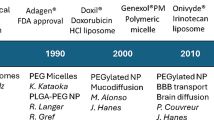Abstract
To assess the merits of PEGylated poly (lactic-co-glycolic acid) (PEG-PLGA) nanoparticles as drug carriers for tumor necrosis factor-α receptor blocking peptide (TNFR-BP), PEG-PLGA copolymer, which could be used to prepare the stealth nanoparticles, was synthesized with methoxypolyethyleneglycol, DL-lactide and glycolide. The structure of PEG-PLGA was confirmed with 1H-NMR and FT-IR spectroscopy, and the molecular weight (MW) was determined by gel permeation chromatography. Fluorescent FITC-TNFRBP was chosen as model protein and encapsulated within PEG-PLGA nanoparticles using the double emulsion method. Atomic force microscopy and photon correlation spectroscopy were employed to characterize the stealth nanoparticles fabricated for morphology, size with polydispersity index and zeta potential. Encapsulation efficiency (EE) and the release of FITC-TNFR-BP in nanoparticles in vitro were measured by the fluorescence measurement. The stealth nanoparticles were found to have the mean diameter less than 270 nm and zeta potential less than −20 mV. In all nanoparticle formulations, more than 45% of EE were obtained. FITC-TNFRBP release from the PEG-PLGA nanoparticles exhibited a biphasic pattern, initial burst release and consequently sustained release. The experimental results show that PEG-PLGA nanoparticles possess the potential to develop as drug carriers for controlled release applications of TNFR-BP.
Similar content being viewed by others
References
Y P He, Z Y Li, X D Jiang, et al. Effect of TNF-α Receptor Blocking Peptide on Adjuvant Arthritis in Rats [J]. Acta Pharm. Sinica, 2003, 38(12): 889–892
Y P He, B G Yin, Z Y Li, et al. The Effect of TNF Receptor Blocking Peptide on the Functions of Rat Peritoneal Macrophages [J]. Chin. J. Immunol., 2003, 19(6): 385–391
T Utsumi, M C Hung, J Klostergaard. Preparation and Characterization of Liposomal Lipophilic Necrosis Factor [J]. Cancer Res., 1991, 51: 3 326–3 366
M F Zambaux, F Bonneaux, R Gref, et al. Preparation and Characterization of Protein C-loaded PLA Nanoparticles [J]. J. Control. Release, 1999, 60: 179–188
R Gref, Y Minamitake, R Langer, et al. Biodegradable Long-circulating Polymeric Nanospheres [J]. Science, 1994, 263: 1 600–1 603
D Bazile, M T Bassoullet, M Marlard, et al. Stealth MePEG-PLA Nanoparticles Avoid Uptake by the Mononuclear Phagocytes System [J]. J. Pharm. Sci., 1995, 84: 493–498
Y Dong, S S Feng. Methyoxy Poly (ethylene glycol)-poly (lactide) Nanoparticles for Controlled Delivery of Anticancer Drugs [J]. Biomaterials, 2004, 25: 2 843–2 849
B Jeong, Y H Bae, S W Kim. Drug Release from Biodegradable Injectable Thermosensitive Hydrogel of PEG-PLGA-PEG Triblock Copolymer [J]. J. Control. Release, 2000, 63: 155–163
C X Song, V Labhasetwar, H Murphy, et al. Formulation and Characterization of Biodegradable Nanoparticles for Intravascular Local Drug Delivery [J]. J. Control. Release, 1997, 43: 197–212
M R Yalamanchili, S Veeramasuneni, J D Miller, et al. Use of Atomic Force Microscopy in Particle Science and Technology Research [J]. Colloids Surf. A, 1998, 133: 77–88
T Gorner, R Gref, E Dellacherie, et al. Lidocaine-loaded Biodegradable Nanosphere: Optimization of the Drug Incorporation into the Polymer Matrix [J]. J. Control. Release, 1999, 57: 259–268
H Fessi, F Puisieux, S Benita, et al. Nanocapsules Formulation by Interfacial Polymer Deposition Following Solvent Displacement [J]. Int. J. Pharm., 1989, 55: 1–4
E Allemann, J C Leroux, R Gurnay, et al. In Vitro Extended-release Properties of Drug-loaded Poly (D, L-lactic acid) Nanoparticles Produced by a Salting-out Procedure [J]. Pharm. Res., 1993, 10: 1 732–1 737
Y Zhang, R X Zhuo. Synthesis and Drug Release Behavior of Poly (trimethylene carbonate)-poly (ethylene glycol)-poly (trimethylene carbonate) Nanoparticles [J]. Biomaterials, 2005, 26: 2 089–2 094
B Heurtauil, P Saulnier, B Pech, et al. Physico-chemical Stability of Collidal Lipid Particles [J]. Biomaterials, 2003, 4: 4 283–4 300
B Magenheim, M T Levy, S Benita. A New in Vitro Technique for the Evaluation of Drug Release Profile from Collidal Carriers: Ultrafiltration Technique at low Pressure [J]. Int. J.
Author information
Authors and Affiliations
Corresponding author
Additional information
Funded by the National 863 Project of China (No. 2004AA215162)
Rights and permissions
About this article
Cite this article
Liu, W., Yang, A., Li, Z. et al. PEGylated PLGA nanoparticles as tumor ecrosis factor-α receptor blocking peptide carriers: Preparation, characterization and release in vitro . J. Wuhan Univ. Technol. 22, 112–116 (2007). https://doi.org/10.1007/s11595-005-1112-4
Received:
Accepted:
Issue Date:
DOI: https://doi.org/10.1007/s11595-005-1112-4




